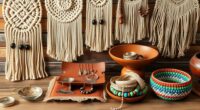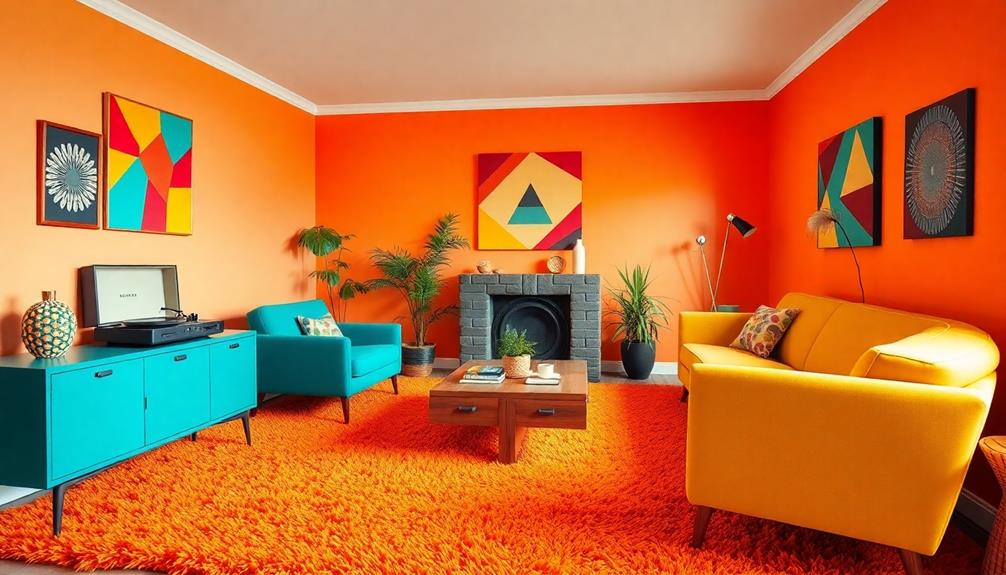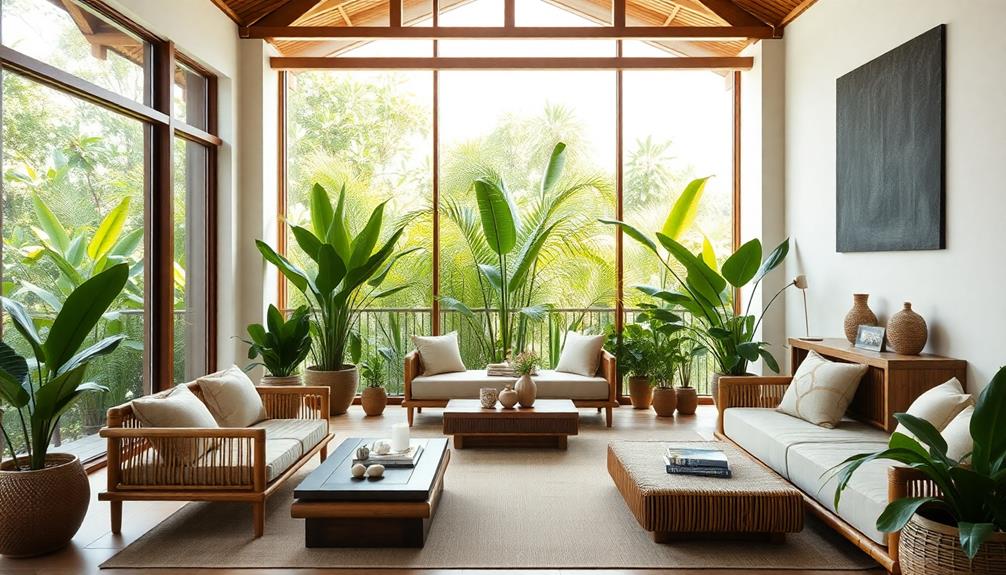Mid-century modern style endures because it combines sleek designs, innovative materials like molded plywood and fiberglass, and functional simplicity that still fit today’s lifestyles. Its bold shapes, vibrant colors, and minimalist appeal create spaces that feel both timeless and fresh. You’ll find iconic furniture and thoughtful layouts that emphasize form and function. If you want to discover why this style keeps inspiring, you’ll find plenty of inspiring ideas and stories as you explore further.
Key Takeaways
- Timeless appeal through clean lines, organic shapes, and innovative materials keeps mid-century modern design relevant today.
- Its seamless blend of form and function creates versatile, stylish spaces that suit contemporary lifestyles.
- Bold colors and distinctive furniture make iconic statements, ensuring lasting visual impact.
- The design’s emphasis on simplicity, practicality, and craftsmanship aligns with modern aesthetic preferences.
- Cultural and historical significance, combined with continued collector interest, sustains its popularity across generations.
The Origins and Evolution of Mid-Century Modern Design
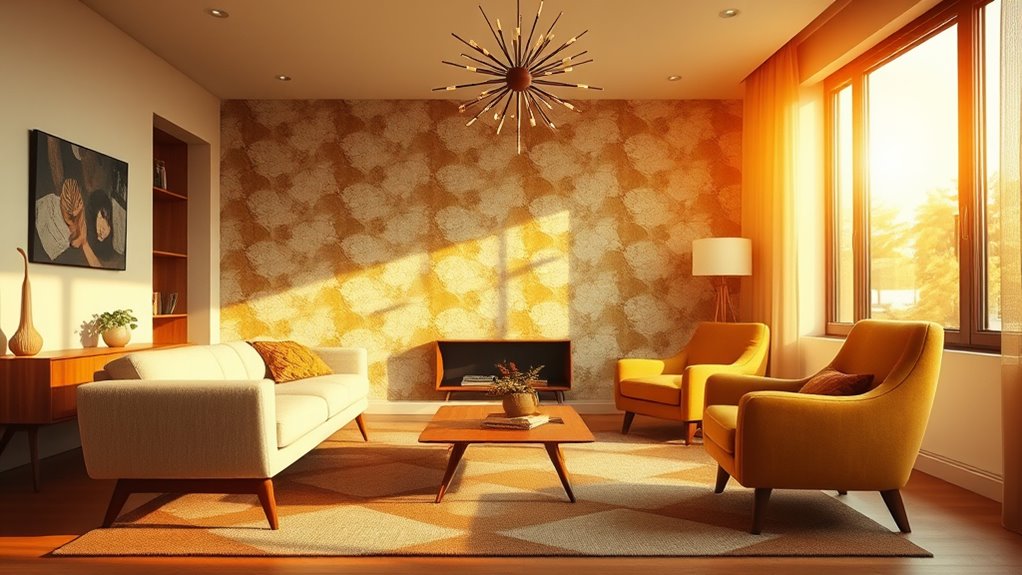
Mid-Century Modern design emerged after World War II, reflecting a desire for simplicity and functionality. This era sparked a vintage revival, bringing back clean lines and minimal ornamentation that emphasize practicality. You’ll notice how the design philosophy focuses on blending form and function seamlessly, prioritizing usability without sacrificing style. During this period, designers embraced innovative materials like molded plywood, fiberglass, and steel, which allowed for sleek, fluid shapes. The movement was a response to the chaos of wartime, seeking to create spaces that were both comfortable and forward-thinking. Over time, Mid-Century Modern evolved, influencing furniture, architecture, and interior design, and establishing a timeless aesthetic that continues to resonate today. Additionally, the movement’s emphasis on simplicity and utility has contributed to its enduring popularity in contemporary design.
Distinctive Features of 60s Style: Shapes and Materials

You’ll notice that 60s style features bold organic and geometric shapes that give furniture and decor a distinctive look. The era also experiments with innovative materials like molded plastic, plywood, and fiberglass, making pieces both functional and stylish. These design choices create a fresh, modern feel that still influences interiors today. Additionally, the era’s embrace of material innovation has helped cement its lasting appeal in contemporary decor, inspiring designers to explore new material applications that continue to shape modern aesthetics.
Organic Geometric Forms
Have you ever noticed how the shapes in 60s design seem to flow effortlessly between the organic and the geometric? This fusion creates organic geometric forms that feel both natural and structured. You’ll see organic motifs inspired by nature—curving lines, leaf shapes, and fluid silhouettes—blended seamlessly with crisp, geometric shapes like circles and ovals. Natural textures, such as wood grain or textured fabrics, enhance this harmony, grounding the design in authenticity. These forms evoke a sense of movement and essentiality, making spaces feel lively yet balanced. The key is in how these shapes combine harmoniously to create a visual rhythm that’s both soothing and dynamic. Incorporating design principles like balance and contrast further emphasizes this interplay, lending a timeless appeal to the overall aesthetic. The use of innovative materials in 60s design also contributed to its distinctive look and enduring popularity. It’s this interplay of organic and geometric that defines the timeless appeal of 60s style.
Innovative Material Use
What sets 60s design apart is its bold use of innovative materials that transformed everyday objects into works of art. You’ll notice the era’s embrace of sustainable innovations and technological advancements, pushing boundaries creatively. Think vibrant plastics, molded plywood, and fiberglass that allowed for fluid, organic shapes. These materials enabled designers to experiment freely, crafting pieces that are both functional and sculptural. Visualize:
- Brightly colored plastic chairs with sleek curves
- Laminated plywood tables with warm, natural tones
- Glossy fiberglass lighting fixtures that seem to glow
- Metal accents with a polished, futuristic finish
- Foam-filled furniture offering comfort and bold forms
This era’s material innovation not only revolutionized aesthetics but also made designs more accessible and sustainable, cementing their timeless appeal. The use of lightweight and durable composite materials further enhanced the versatility and longevity of 60s furniture and decor. Additionally, the integration of these materials often contributed to the distinctive visual style characteristic of the decade.
The Blend of Functionality and Aesthetic Appeal

Mid-Century Modern design seamlessly combines practicality with visual appeal, creating spaces that are both functional and stylish. You’ll notice how vintage nostalgia influences the charm of iconic furniture pieces, blending timeless appeal with fresh design innovation. This style prioritizes clean lines, simple forms, and uncluttered layouts, ensuring each item serves a purpose without sacrificing beauty. Functionality doesn’t come at the expense of aesthetic appeal; instead, they enhance each other. You’ll find how clever storage solutions and versatile furniture make your space efficient, while bold colors and sleek designs add visual interest. Additionally, design principles from the 60s emphasize harmony between form and function, which remains influential in modern interiors. This balance ensures your home feels inviting and practical, proving that smart design can be both useful and engaging—making Mid-Century Modern a lasting favorite. Incorporating space and organization strategies can further enhance the practicality of this style, helping to maintain a clutter-free environment that highlights its aesthetic qualities. Embracing timeless appeal ensures your decor remains relevant and stylish for years to come.
How Mid-Century Modern Influences Contemporary Living Spaces

The timeless appeal of Mid-Century Modern design continues to shape how you create contemporary living spaces today. Its emphasis on furniture craftsmanship brings a sleek, minimalist vibe, with pieces that blend form and function effortlessly. You might notice how clean lines and organic shapes define your space, making it feel open and inviting. Interior lighting plays a vital role, with iconic pendant lights and floor lamps casting warm, ambient glows that highlight your furniture’s craftsmanship. Visualize:
- A walnut coffee table with smooth, rounded edges
- Sleek, tapered-legged chairs in vibrant upholstery
- Pendant lights with geometric shapes hanging above
- Large windows framing natural light
- Clutter-free surfaces emphasizing simplicity
This style seamlessly integrates past elegance with modern comfort, shaping your space into a timeless sanctuary. Design principles help ensure your space feels both stylish and functional, and understanding the zodiac sign compatibility can also inspire personalized touches that resonate with your personality. Incorporating exfoliation benefits through thoughtful design elements can enhance the overall aesthetic and comfort of your space.
The Enduring Popularity of Iconic Pieces and Designers

Iconic mid-century modern furniture pieces and designers have maintained their popularity because their innovative designs and craftsmanship continue to resonate today. The Vintage Revival has fueled increased interest in authentic pieces, driving demand among collectors and enthusiasts alike. Market trends show a steady rise in the value of classics like Eames chairs and Saarinen tables, reflecting their timeless appeal. These designs stand out for their clean lines, functional form, and enduring quality, making them a smart investment. The legacy of designers like Charles and Ray Eames or Arne Jacobsen remains relevant, inspiring new generations. As a result, their pieces remain sought-after symbols of style, blending nostalgia with modern sophistication, ensuring their influence endures in both vintage markets and contemporary interiors. Additionally, the timeless appeal of their work continues to inspire innovations in modern design. The durability and universal appeal of these pieces are also a testament to the exceptional craftsmanship that defined their era.
Incorporating 60S Elements Into Modern Interiors

Incorporating 60s elements into your modern space is all about bold color palettes and sleek furniture shapes that make a statement. You can add minimalist decor accents to keep the look fresh and uncluttered. Incorporating vintage patterns and materials and textures enhances the authenticity and warmth of the design. Together, these choices create a vibrant, timeless vibe that bridges mid-century charm with contemporary style.
Bold Color Palettes
Bold color palettes define mid-century modern interiors by infusing spaces with vibrant energy and personality. These vibrant room schemes rely on striking hues that create a lively atmosphere. You might incorporate:
- Bright oranges and yellows that evoke warmth and optimism
- Deep teals and aquas for an invigorating, cool contrast
- Rich reds and pinks to add drama and passion
- Bold greens that bring a touch of nature indoors
- Accents of black and white for sharp, modern accents
Using these bold color palettes, you can transform a simple room into a lively, eye-catching space. They balance retro charm with a contemporary twist, ensuring your interior remains timeless. Incorporating these vibrant elements keeps your space energetic and true to the 60s aesthetic. Additionally, embracing minimalist design principles can help highlight these bold colors without overwhelming the space, and understanding cookie categories can enhance your browsing experience while exploring interior design ideas.
Sleek Furniture Shapes
Sleek furniture shapes bring a streamlined, minimalist aesthetic to mid-century modern interiors, perfectly complementing bold color palettes. Their clean lines and smooth curves create a sense of openness and sophistication. To enhance this look, incorporate vintage textiles with geometric or abstract decorative motifs that echo 60s design elements. These textiles add texture and visual interest without cluttering the space. The furniture itself often features tapered legs, rounded edges, and simple silhouettes, emphasizing form and function. By combining these sleek shapes with vintage-inspired textiles, you craft a cohesive environment that honors the era’s timeless style while feeling fresh and contemporary. The key is balancing simplicity with subtle decorative touches, allowing the furniture’s shape to stand out and anchor your overall design. Additionally, incorporating eye patches can add a quirky, modern twist to the decor, blending functionality with style in unexpected ways.
Minimalist Decor Accents
Adding minimalist decor accents inspired by the 60s can effortlessly elevate your modern interiors. Focus on creating vintage vignettes that showcase clean lines and bold shapes, emphasizing simplicity while capturing the era’s essence. Incorporate sleek, geometric vases, abstract wall art, and understated lighting fixtures to add subtle retro flair. Use minimalist accents sparingly to keep the space uncluttered but visually engaging. Think of a single, sculptural lamp or a streamlined coffee table as focal points. These touches evoke the 60s aesthetic without overwhelming your contemporary design. By blending vintage vignettes with minimalist decor accents, you achieve a harmony that’s both nostalgic and fresh, making your space timeless and inviting.
The Cultural and Social Impact on Design Trends
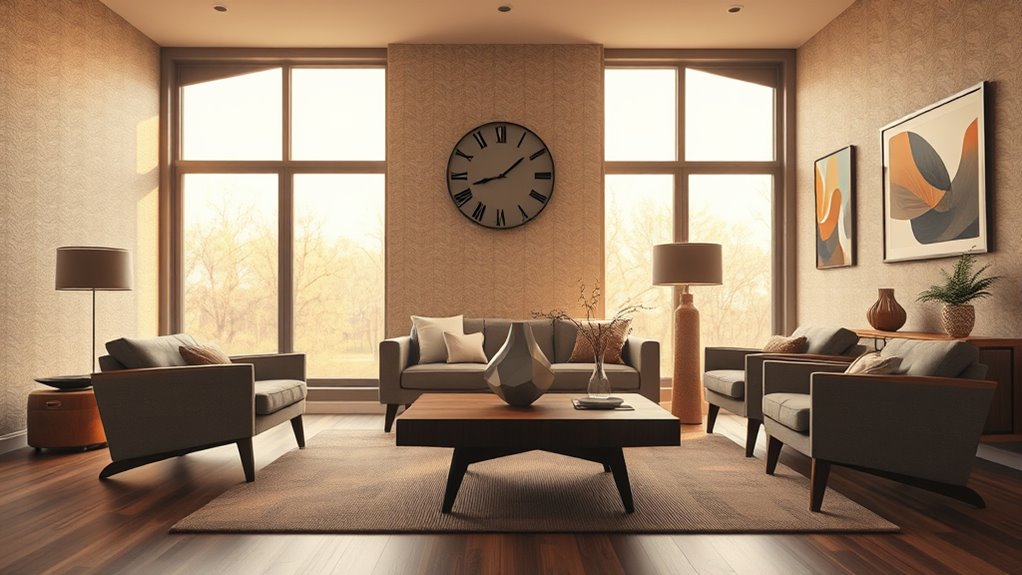
The cultural and social shifts of the mid-20th century profoundly influenced design trends, shaping the clean lines and functional forms characteristic of Mid-Century Modern style. You can see this impact in how fashion trends of the era embraced simplicity and practicality, reflecting a move towards minimalism. Social movements, like the push for gender equality and greater individual expression, also played a role, inspiring designers to create pieces that prioritized function and accessibility. The post-war optimism and desire for progress encouraged a break from ornate Victorian styles, favoring sleek, innovative designs that emphasized efficiency. As a result, Mid-Century Modern design became a reflection of the era’s social values—forward-thinking, egalitarian, and embracing new technologies.
Why Collectors and Enthusiasts Continue to Celebrate the Style
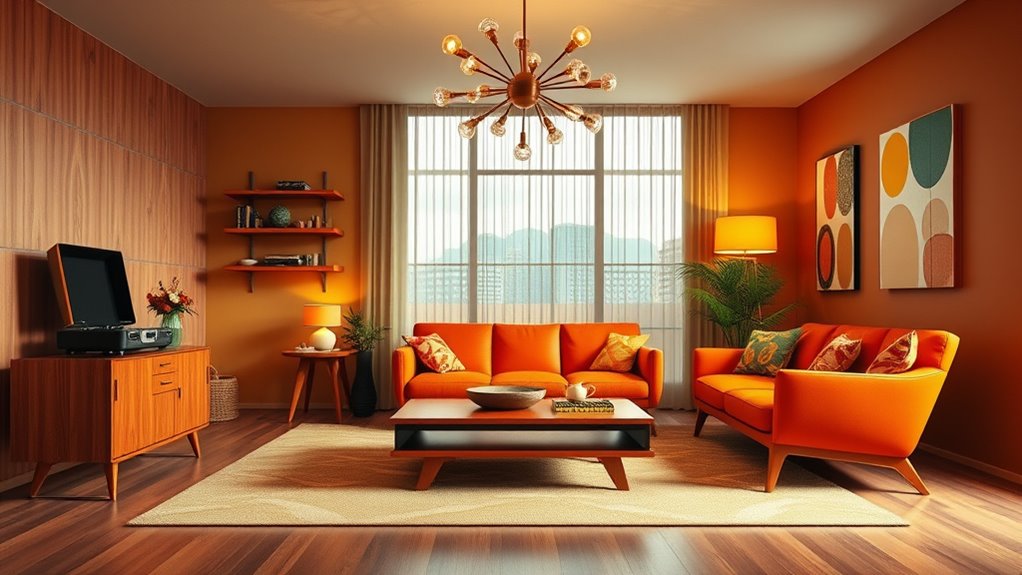
Collectors and enthusiasts continue to celebrate Mid-Century Modern style because it captures the spirit of innovation and optimism that defined the era. Its vintage appeal evokes nostalgia, reminding you of a time when bold ideas transformed everyday life. The style’s clean lines and organic forms create a sense of harmony and simplicity that still feels fresh. You might picture:
Celebrating Mid-Century Modern design’s timeless blend of innovation, nostalgia, and harmonious simplicity.
- Sleek, geometric furniture that feels both functional and artistic
- Bright, optimistic color palettes that energize any space
- Iconic lighting fixtures that cast warm, inviting glows
- Vintage posters and artwork that tell stories of progress
- Textured fabrics that add tactile interest and warmth
This timeless influence continues to inspire new generations, proving that Mid-Century Modern design remains relevant and beloved.
Frequently Asked Questions
How Did Mid-Century Modern Design Influence Global Architectural Trends?
You see how mid-century modern design shaped global architecture by emphasizing simplicity, functionality, and clean lines. Iconic architects like Charles and Ray Eames and Eero Saarinen popularized these design philosophies, influencing structures worldwide. Their focus on innovative materials and minimalism inspired modern buildings, making mid-century modern a timeless style. This movement’s emphasis on form following function continues to influence contemporary architecture, proving its lasting impact across cultures and design disciplines.
Are There Specific Materials That Define 60S Furniture Beyond Wood and Metal?
You’ll notice that 60s furniture isn’t just about wood and metal. Plastic composites became popular, offering sleek, colorful options, while fiberglass accents added a futuristic vibe. These materials allowed designers to experiment with shapes and textures, making furniture more vibrant and innovative. Their use defined the era’s aesthetic, giving pieces a distinctive look that still influences modern design today.
Can Mid-Century Modern Style Be Adapted to Small or Urban Living Spaces?
Imagine if your tiny apartment felt like a vintage loft—thanks to space-saving solutions inspired by mid-century modern design. You can adapt this style to small or urban spaces by choosing sleek furniture with clean lines, multi-functional pieces, and smart storage options. Embrace urban aesthetics by adding bold accents and minimalist decor. This approach maximizes your limited space while keeping the timeless charm of the 60s alive in your modern lifestyle.
What Are Some Common Misconceptions About 60S Interior Design?
You might think 60s interior design is just bold patterns and bright colors, but that’s a misconception. It’s about vintage authenticity and understated elegance, with design versatility that adapts to modern needs. Many believe it’s outdated, yet it offers timeless style that can blend with contemporary decor. Embracing its simplicity and functionality lets you create a space that feels both nostalgic and fresh, proving its lasting appeal.
How Has Digital Technology Impacted the Preservation of Mid-Century Modern Furniture?
Digital technology dramatically delights designers and collectors by enabling digital restoration, making vintage furniture look pristine and perfect. You can easily browse online marketplaces to buy and sell mid-century modern pieces, expanding access globally. This tech-driven trend preserves the past, promotes passion, and propels preservation efforts forward. By blending bold breakthroughs with beautiful history, digital advancements make maintaining and mastering mid-century modern furniture more manageable, meaningful, and memorable.
Conclusion
So, as you explore the sleek lines and timeless charm of mid-century modern design, you’ll realize it’s more than just a trend—it’s a lasting legacy. With its blend of form and function, the 60s style continues to shape your spaces in surprising ways. But what innovations will future designers draw from this iconic era? Only time will tell, leaving you enthusiastic to see how this enduring style evolves and surprises once again.

